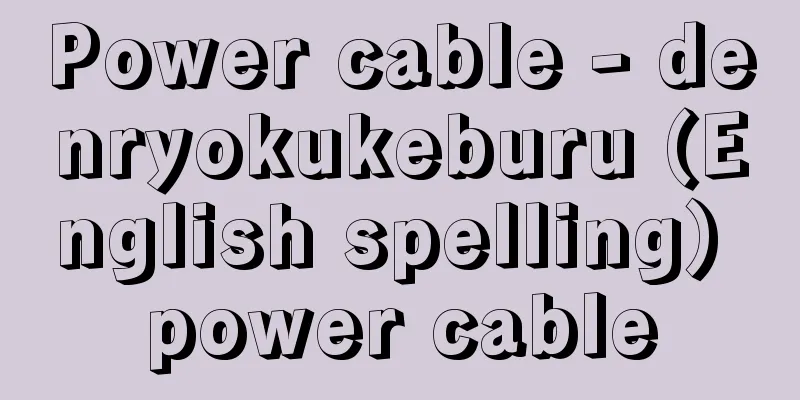Power cable - denryokukeburu (English spelling) power cable

|
A cable that is buried underground in urban areas and industrial districts to transmit electricity. Typical types are OF cable (oil filled cable) and CV cable (cross-linked polyethylene insulated vinyl sheath cable). [Teruo Sakuma and Yoshiji Oki] OF cableIt was invented in 1917 by Luigi Emanueli (1883-1959) of the Italian company Pirile. It has been manufactured in Japan since 1930 (Showa 5). It is widely used around the world, mainly for power cables of 60 kilovolts or more, and there are also versions for 500 kilovolts. The world's highest voltage for direct current is 800 kilovolts, and Sumitomo Electric Industries delivers to Canada. The highest voltage for alternating current is 500 kilovolts. There are two types of cable: a single-core cable with an oil passage in the center of the conductor, and a three-core cable with the gaps between the strands used as the oil passage, and the conductor is made of soft copper strands wrapped in insulating paper, then dried, oil-soaked, coated with lead or aluminum, and protected from corrosion. The insulating oil used is low-viscosity oil that has been degassed and refined to facilitate flow along the length of the cable, and to prevent voids (air gaps) from forming in the insulator and causing deterioration, the cable is connected to a device that keeps the hydraulic pressure inside the cable above atmospheric pressure regardless of the outside temperature or load. At present, efforts are being made to reduce loss in OF cables by using semi-synthetic paper, etc. In addition, development of superconducting cables that utilize OF cable technology is also underway. These superconducting cables are also being applied to demonstration lines. [Teruo Sakuma and Yoshiji Oki] CV cableThis cable has improved heat resistance by using cross-linked polyethylene (XLPE) as insulation, which is made by cross-linking the molecular structure of low-density polyethylene into a three-dimensional mesh. The sheath (coating) is made of polyvinyl chloride. The "C" in CV stands for "cross-linked," and the "V" for "vinyl." It is mainly used for 600 volts to 500 kilovolts, and accounts for most new 66 kilovolt-class lines. The English term "XLPE cable" is more commonly used. [Teruo Sakuma and Yoshiji Oki] [Reference item] |Source: Shogakukan Encyclopedia Nipponica About Encyclopedia Nipponica Information | Legend |
|
市街地や工場地帯などで地中に埋設して電力輸送に使用されるケーブル。OFケーブル(油入りケーブルoil filled cable)とCVケーブル(架橋ポリエチレン絶縁ビニルシースケーブル)が代表的なものである。 [佐久間照夫・大木義路] OFケーブル1917年イタリアのピリレ社のエマヌエリLuigi Emanueli(1883―1959)が考案した。日本では1930年(昭和5)から製造されている。世界各国で主として60キロボルト以上の電力ケーブルに広く使用され、500キロボルト用のものもある。世界最高電圧は直流では800キロボルトで、カナダに住友電気工業が納入している。また、交流では500キロボルトが最高電圧である。 構造は、導体の中心に油通路を設けた単心ケーブルと、撚(よ)り合わせ間隙(かんげき)を油通路とした三心ケーブルとがあり、軟銅撚り線の導体に絶縁紙を巻き、乾燥、浸油、鉛あるいはアルミ被覆および防食を行う。絶縁油はケーブル長さ方向の流動を容易にするために低粘度の油を脱ガス精製したものを用い、絶縁体中にボイド(空隙(くうげき))が生じ劣化することを防ぐため、ケーブル内の油圧を外温や負荷にかかわらずいつも大気圧以上に保つ装置に連結されている。 現在、OFケーブルは半合成紙等の適用による低損失化が進められている。また、OFケーブルの技術を生かした超電導ケーブル等の開発も進められている。この超電導ケーブルについては、実証線路への適用も行われている。 [佐久間照夫・大木義路] CVケーブル低密度ポリエチレンの分子構造を立体網目状に架橋させた架橋ポリエチレン(cross-linked polyethylene、略語はXLPE)を絶縁体に用いて、耐熱性を向上させたケーブル。シース(被覆)には、ポリ塩化ビニルが用いられる。CVのCは架橋cross、Vはビニルvinylの英語の頭文字からきている。主として、600ボルト~500キロボルトに用いられ、とくに66キロボルト級の新設線路のほとんどを占めている。なお、英語表記としてはXLPE cableが一般的である。 [佐久間照夫・大木義路] [参照項目] |出典 小学館 日本大百科全書(ニッポニカ)日本大百科全書(ニッポニカ)について 情報 | 凡例 |
<<: Electric power bonds - denryokusai
Recommend
Les Miserables
A full-length novel by French poet and novelist Hu...
Kowalewski, G.
...The knight is a knight that can jump in any of...
Black-tailed prairie dog
...The name "dog" comes from the sharp ...
Staatliche Kunstsammlungen, Dresden
This is one of the museums belonging to the Dresde...
Suetonius - Gaius Suetonius Tranquillus
A biographer of the early Roman Empire. A friend ...
Food and drink consumption tax - Ryōriinshokutōshōhizei
This tax was levied as one of the local taxes. It...
《Anthology》
…Florence soon became a base for liberal reformer...
Mustafa Koç Bey (English)
…On the other hand, Mustafa 'Ali (?-1606), Pe...
Reciprocal
When a given number is multiplied with another nu...
Central Pacific Railroad
…After the Oregon region (1846) and the Californi...
Wallack - Wallack
…They are told only in winter. On the other hand,...
Legal philosophy - Rechtsphilosophie; legal philosophy; jurisprudence
A field of study that studies fundamental and fund...
Breeding - Breeding
It refers to the processes used to purposefully c...
Katano Kinya - Katano Kinya
...However, as shown by the fact that in 978 (Ten...
Cosa Nostra (English spelling)
...The Mafia establishes its authority through th...









